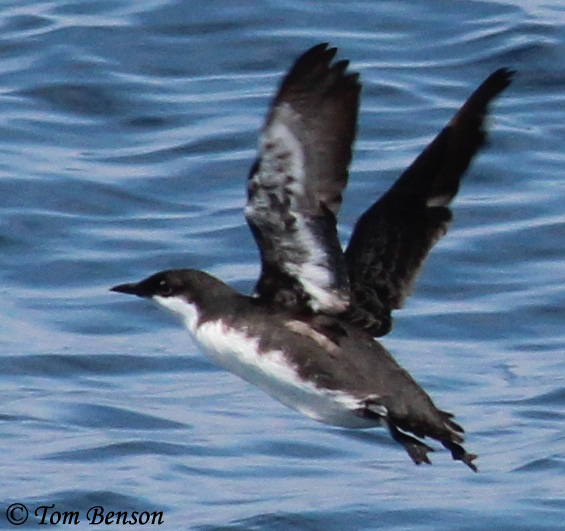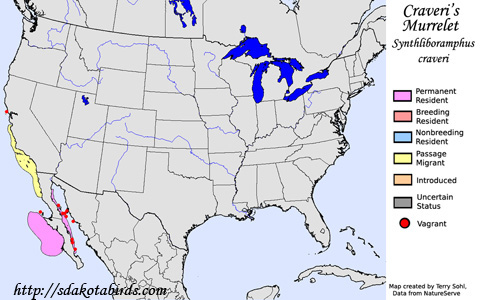| Length: 9.5 inches | Wingspan: 15 inches | Seasonality: Non-resident in South Dakota |
| ID Keys: Dark upperparts and white underparts, black on head extends below eyes and has a relatively "clean" boundary with white below. | ||
 The
Craveri's Murrelet is found in a relatively small geographic area, around
Baja California at all seasons. They are known in the United States by
birds that occasionally move up the Pacific coast after the breeding season,
in the late summer. They are very similar in overall appearance to the
Scripp's Murrelet and the
Guadalupe Murrelet (see notes
below). Craveri's Murrelet likely number no more than 10,000, and are
considered a "vulnerable" species by the IUCN (see below).
The
Craveri's Murrelet is found in a relatively small geographic area, around
Baja California at all seasons. They are known in the United States by
birds that occasionally move up the Pacific coast after the breeding season,
in the late summer. They are very similar in overall appearance to the
Scripp's Murrelet and the
Guadalupe Murrelet (see notes
below). Craveri's Murrelet likely number no more than 10,000, and are
considered a "vulnerable" species by the IUCN (see below).
Habitat: During the breeding season, Craveri's Murrelet are found on rocky islands or islands with protected nesting sites like bushes. They can sometimes be found relatively far from the shore when feeding and when not breeding, but more often they are in and around the continental shelf.
Diet: Primarily feeds on small fish
Behavior: Forages by diving under the water's surface, propelling itself with its feet as it chases prey.
Nesting: The Craveri's Murrelet breeds in a small number of island locations around Baja California, in loose colonies. The nesting site is a protected site such as a rocky crevice or the base of a shrub. The female lays 2 eggs directly on the ground, and both parents help to incubate them. The young leave the nest just a day or two after hatching, following the parents to the ocean, where they are raised.
Song: At sea they will occasionally give a high-pitched, rattling trill.
Migration: Craveri's Murrelets nest on a few islands off the west coast of Mexico, and they are found in the same general area at all seasons. However, some birds do move northward along the Pacific Coast in the late summer, where they can sometimes be seen relatively close to shore off the California coast.
Interactive eBird Map: Click here to access an interactive eBird map of Craveri's Murrelet sightings
Similar Species: Very similar to the Scripp's Murrelet and the Guadalupe Murrelet. On adult birds, Scripp's and Guadalupe Murrelets have white underwings with dark edges, while Craveri's Murrelet underwings are darker and mostly grayish.
Conservation Status: The IUCN lists the Craveri's Murrelet as a "Vulnerable" species, due to a relatively small population, the reliance on a small number of breeding islands, and the introduction of rats and other predators to their breeding sites.
Further Information: 1) Audubon - Craveri's Murrelet
2) BirdLife International - Craveri's Murrelet
3) Arkive.org - Craveri's Murrelet
Photo Information: Photo taken by Tom Benson - September 22nd, 2012 - Near Laguna Beach, California - Photo licensed under Creative Commons Attribution NonCommercial NoDerivs 2.0 Generic License.
| Click below for a higher-resolution map |
 |
| South Dakota Status: Non-resident in South Dakota |
Additional Craveri's Murrelet Photos (coming soon!!)
